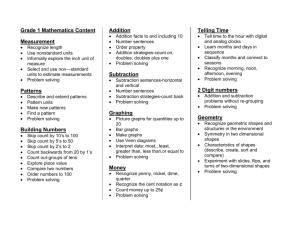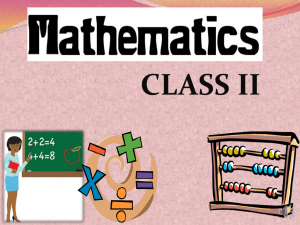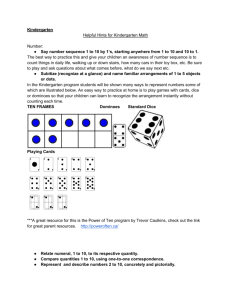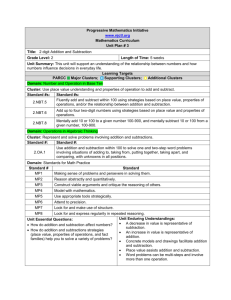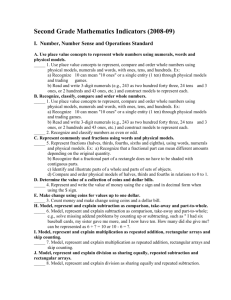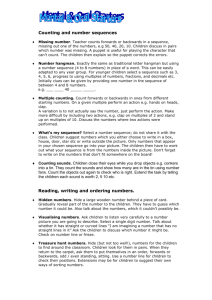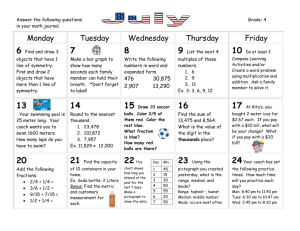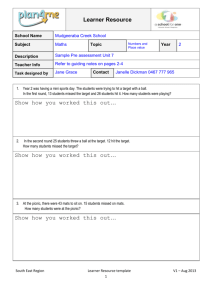Grade 2 Mathematics Content
advertisement
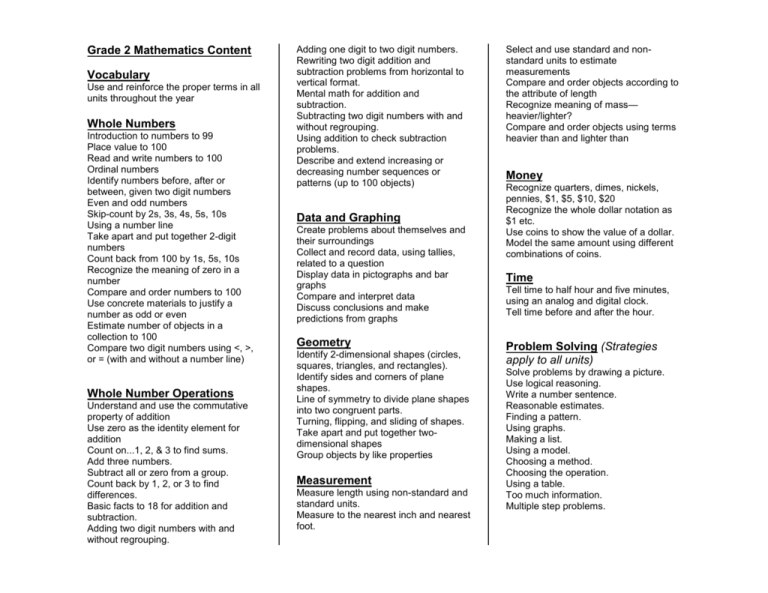
Grade 2 Mathematics Content Vocabulary Use and reinforce the proper terms in all units throughout the year Whole Numbers Introduction to numbers to 99 Place value to 100 Read and write numbers to 100 Ordinal numbers Identify numbers before, after or between, given two digit numbers Even and odd numbers Skip-count by 2s, 3s, 4s, 5s, 10s Using a number line Take apart and put together 2-digit numbers Count back from 100 by 1s, 5s, 10s Recognize the meaning of zero in a number Compare and order numbers to 100 Use concrete materials to justify a number as odd or even Estimate number of objects in a collection to 100 Compare two digit numbers using <, >, or = (with and without a number line) Whole Number Operations Understand and use the commutative property of addition Use zero as the identity element for addition Count on...1, 2, & 3 to find sums. Add three numbers. Subtract all or zero from a group. Count back by 1, 2, or 3 to find differences. Basic facts to 18 for addition and subtraction. Adding two digit numbers with and without regrouping. Adding one digit to two digit numbers. Rewriting two digit addition and subtraction problems from horizontal to vertical format. Mental math for addition and subtraction. Subtracting two digit numbers with and without regrouping. Using addition to check subtraction problems. Describe and extend increasing or decreasing number sequences or patterns (up to 100 objects) Data and Graphing Create problems about themselves and their surroundings Collect and record data, using tallies, related to a question Display data in pictographs and bar graphs Compare and interpret data Discuss conclusions and make predictions from graphs Geometry Identify 2-dimensional shapes (circles, squares, triangles, and rectangles). Identify sides and corners of plane shapes. Line of symmetry to divide plane shapes into two congruent parts. Turning, flipping, and sliding of shapes. Take apart and put together twodimensional shapes Group objects by like properties Measurement Measure length using non-standard and standard units. Measure to the nearest inch and nearest foot. Select and use standard and nonstandard units to estimate measurements Compare and order objects according to the attribute of length Recognize meaning of mass— heavier/lighter? Compare and order objects using terms heavier than and lighter than Money Recognize quarters, dimes, nickels, pennies, $1, $5, $10, $20 Recognize the whole dollar notation as $1 etc. Use coins to show the value of a dollar. Model the same amount using different combinations of coins. Time Tell time to half hour and five minutes, using an analog and digital clock. Tell time before and after the hour. Problem Solving (Strategies apply to all units) Solve problems by drawing a picture. Use logical reasoning. Write a number sentence. Reasonable estimates. Finding a pattern. Using graphs. Making a list. Using a model. Choosing a method. Choosing the operation. Using a table. Too much information. Multiple step problems. New York State Education Department Learning Standard for Mathematics Students will understand the concepts of and become proficient with the skills of mathematics; communicate and reason mathematically; become problem solvers by using appropriate tools and strategies through the integrated study of number sense and operations, algebra, geometry, measurement, and statistics and probability. Content Strands Strand 1: Number Sense and Operations Definition Example Students will understand numbers, multiple ways of representing numbers, 1. Verbally count by 1’s to 20. relationships among numbers, and number systems; understand meanings 2. Solve proportions using equivalent fractions. of operations and procedures, and how they relate to one another; compute accurately and make reasonable estimates. Strand 2: Algebra Students will represent and analyze algebraically a wide variety of problem solving situations; perform algebraic procedures accurately; recognize, use, and represent patterns, relations, and functions algebraically. 1. Use a variety of manipulative materials to create patterns using attributes of color, size, or shape. 2. Solve simple one-step equations using basic whole number facts. Strand 3: Geometry Students will use visualization and spatial reasoning to analyze characteristics and properties of geometric shapes; identify and justify geometric relationships, formally and informally; apply transformations and symmetry to analyze problem solving situations; apply coordinate geometry to analyze problem solving situations. 1. Identify and appropriately name twodimensional shapes: circle, square, rectangle, and triangle (both regular and irregular). 2. Classify angles as acute, obtuse, right and straight. Strand 4: Measurement Students will determine what can be measured and how, using appropriate methods and formulas; use units to give meaning to measurements; understand that all measurement contains error and be able to determine its significance; develop strategies for estimating measurements. 1. Compare the length of two objects by representing each length with string or a paper strip. 2. Identify radius, diameter, chords, and central angles of a circle. Strand 5: Statistics and Probability Students will collect, organize, display, and analyze data; make predictions that are based upon data analysis; understand and apply concepts of probability. 1. Display data in bar graphs using concrete objects with intervals of one. 2. Calculate the mean for a given set of data and use it to describe a set of data. S:\Ci\MS Word\Math\New Parent Handouts 2005\Gd.2. Parent Handout.doc 1. Example for Primary Instruction. 2. Example for Intermediate Instruction.
